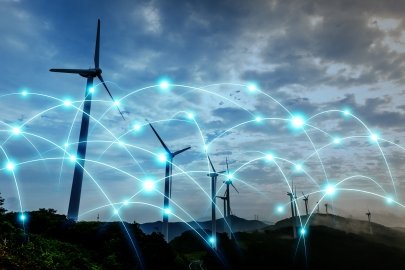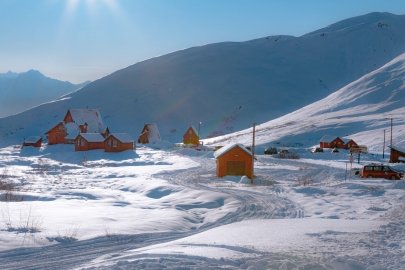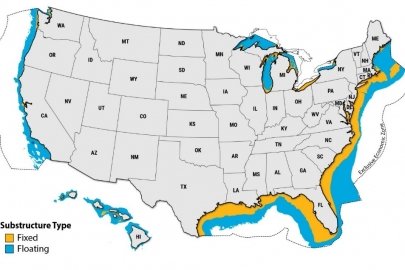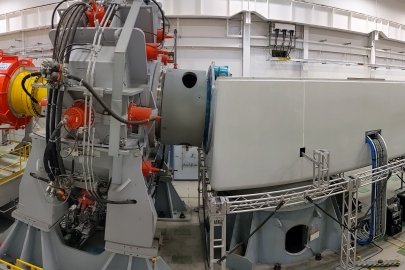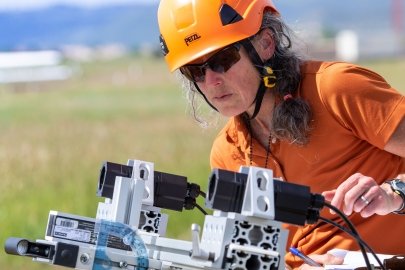When you work in wind, time flies. This year the Wind Energy Technologies Office has plenty of progress and exciting news to report for 2023.
Wind Energy Technologies Office
May 22, 2023When you work in wind, time flies. So far in 2023, the U.S. Department of Energy's (DOE) Wind Energy Technologies Office (WETO) has plenty of progress and exciting news to report.
This letter is part of the
Spring 2023 R&D Newsletter
In This Issue
Firstly, congratulations to the winners of two competitions sponsored by DOE.
Last week, the final event of the 2023 Collegiate Wind Competition (CWC) took place in Boulder, Colorado, and Kansas State University took the top prize. Thirteen teams competed in the finals of this 10th annual CWC. You can read about the first-, second-, and third-place winners, as well as the winners of the individual contests, in last week’s announcement.
Collegiate programs like the CWC develop the technical talent needed to address the challenges from the expected rapid expansion of wind energy. This competition sets the stage for our industry’s future workforce—the engineers, researchers, analysts, economists, communicators, and other contributors—to tackle both existing and future challenges in the world of wind energy. These students bring diverse and fresh perspectives and are exactly what this industry needs to move our nation forward to a carbon-free future.
Earlier this spring, DOE announced winners in the first phase of the Floating Offshore Wind ReadINess (FLOWIN) Prize, a competition that will help build, support, and expand the floating offshore wind energy industry. The three-phase competition, which is open to floating wind platform designers, fabricators, and developers, aims to bridge manufacturing and logistics gaps to help meet the nation’s goals to reduce the cost of floating offshore wind by 70% and deploy 15 gigawatts by 2035.
Congratulations to all nine winners of Phase One, which focused on analyzing critical manufacturing and supply chain challenges to the commercialization of floating offshore wind technologies. You can see the list of winning teams in the official FLOWIN announcement.
Meanwhile, at WETO we’re looking forward to implementing DOE’s strategy to advance offshore wind alongside colleagues from across the department in support of the nationwide effort to deploy 30 gigawatts of offshore wind energy by 2030. and set the nation on a path to install 110 gigawatts or more by 2050.
Around here, it’s easy to get excited about the future, but what’s happening today is incredible, too. This edition of our R&D newsletter provides information about wind energy research from our partners. You’ll read about:
- WETO-funded research that focuses on reducing cybersecurity threats to the nation’s wind fleet. Research teams from three national laboratories are working proactively to strengthen security measures, policies, and information technology infrastructure for wind turbines, while cybersecurity measures are also incorporated into wind turbine designs.
- The Defense and Disaster Deployable Turbine project, which brought together resources from three national laboratories to analyze how to build a wind turbine that could serve both military and humanitarian missions around the world.
- The Microgrids, Infrastructure Resilience, and Advanced Controls Launchpad project, which confirms that distributed wind energy could be a cost-effective source of clean power to many communities, especially those in remote and rural areas.
- The West Coast Offshore Wind Transmission Literature Review and Gaps Analysis, which summarizes 13 existing studies focusing on the technical evaluation of offshore wind energy transmission through potential points of interconnection located along the western U.S. coastline. No comprehensive efforts had been undertaken to review these studies and identify gaps from a whole-system perspective—until now.
- Ways to simulate real-life situations to test offshore wind energy components in a laboratory setting. WETO funded new facilities at Lehigh University, Clemson University, and Oregon State University to enable hybrid testing—combining the benefits of both physical field tests and computerized simulations—to capture the broadest, most reliable information about offshore wind energy systems.
- A publicly available tool that combines past years’ wind energy project capital costs with global wind energy deployment forecasts to estimate the future cost of offshore wind energy.
- Shari Matzner, senior computer scientist at Pacific Northwest National Laboratory. Matzner develops technology to support sustainable ocean energy and national security objectives. Learn more about her unique professional journey in wind energy.
And there’s more! If you’re at CLEANPOWER 2023, stop by our booth (#1623) to see what we’re working on and to chat about the future of wind energy. We hope to see you there.
Sincerely,
Jim Ahlgrimm
Acting Director, Wind Energy Technologies Office
Subscribe to the WETO e-newsletter to stay informed on the latest wind energy news, events, publications, and updates.


